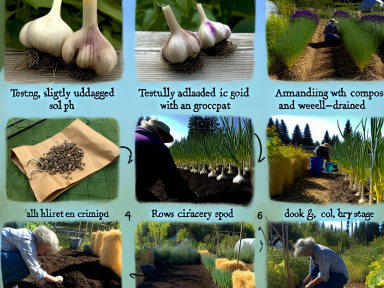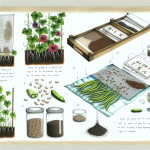Understanding Garlic Growth
Growing garlic from cloves can be a deeply satisfying process, and it allows you to ensure the quality and flavor of your garlic. It’s more than just planting cloves into the ground; it’s about nurturing them to produce the full, robust garlic bulbs that every gardener dreams of.
Choosing the Right Cloves
Not all cloves are created equal. For the best chances of success:
- **Opt for Organic Garlic:** Grocery store garlic is often treated to prevent sprouting. Choose organic cloves from a reputable source.
- **Select the Largest Cloves:** Larger cloves tend to produce more vigorous plants and larger bulbs.
- **Avoid Damaged Cloves:** Any clove that is bruised or has visible damage should not be planted.
Preparing the Soil
Garlic thrives in well-drained soil with plenty of organic matter. Follow these steps to prepare your soil:
- **Test the Soil pH:** Garlic prefers a slightly acidic to neutral pH (6.0 to 7.0). Adjust the pH if necessary using lime or sulfur.
- **Amend with Compost:** Add a generous amount of compost to enrich the soil. A couple of inches worked into the top 6-8 inches of soil is ideal.
- **Ensure Proper Drainage:** Garlic does not like wet feet. Consider raised beds if your soil is clay-heavy or poorly draining.
Planting the Cloves
Timing and spacing are crucial when planting garlic:
- **Time It Right:** Planting should be done in the fall, a few weeks before the ground freezes. This allows the garlic to establish roots before going dormant for the winter.
- **Spacing:** Plant cloves 6 inches apart, in rows spaced 12 inches apart. Each clove should be planted pointed end up, 2 inches deep.
- **Mulch Heavily:** After planting, cover the bed with 4-6 inches of mulch to insulate the soil and protect the garlic from extreme cold. Straw is an excellent choice.
Caring Throughout the Season
Garlic requires consistent care to achieve the best results:
- **Water Wisely:** Keep the soil consistently moist but not waterlogged. Overwatering can lead to rot, while underwatering can stunt growth.
- **Fertilize Moderately:** In spring, as growth begins, side-dress with a balanced fertilizer. Avoid high nitrogen fertilizers that encourage foliar growth at the expense of bulbs.
- **Control Weeds:** Garlic competes poorly with weeds. Keep the bed weed-free by hand weeding or using mulch to suppress weed growth.
Harvesting and Curing
Knowing when to harvest and how to cure garlic is essential for long-term storage:
- **Harvest Timing:** Garlic is ready to harvest when a few of the lower leaves turn brown, but 5-6 upper leaves remain green. Typically, this is in mid to late summer.
- **Harvest Gently:** Use a garden fork to lift the bulbs carefully. Avoid pulling by the stems to prevent damage.
- **Curing Process:** Dry the garlic in a well-ventilated, shaded area for 3-4 weeks. Ensure adequate air circulation to prevent mold. Once cured, trim the roots and cut the stems down to about an inch.
Storing Your Garlic
For long-term storage, keep garlic in a cool, dry, and dark place. Ensure that air can circulate around the bulbs to prevent any mold or sprouting.
Mastering the art of regrowing garlic from cloves takes patience and attention to detail, but the reward of homegrown, fresh garlic is well worth the effort. By following these steps, you can ensure a successful garlic harvest year after year.



GIPHY App Key not set. Please check settings